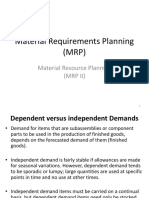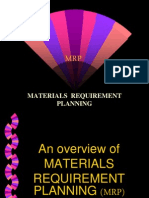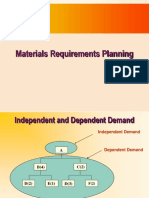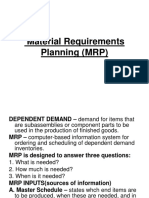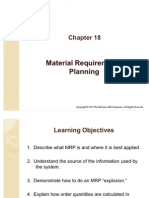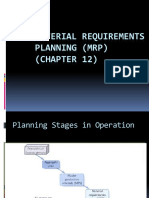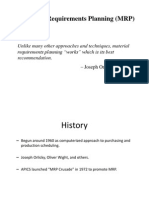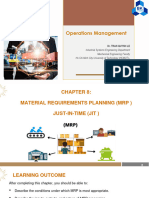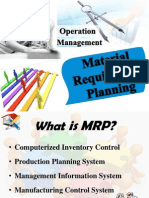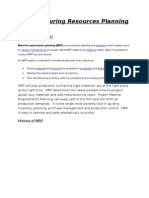Chapter 12: Learning Objectives: - You Should Be Able To
Chapter 12: Learning Objectives: - You Should Be Able To
Uploaded by
DACopyright:
Available Formats
Chapter 12: Learning Objectives: - You Should Be Able To
Chapter 12: Learning Objectives: - You Should Be Able To
Uploaded by
DAOriginal Description:
Original Title
Copyright
Available Formats
Share this document
Did you find this document useful?
Is this content inappropriate?
Copyright:
Available Formats
Chapter 12: Learning Objectives: - You Should Be Able To
Chapter 12: Learning Objectives: - You Should Be Able To
Uploaded by
DACopyright:
Available Formats
Chapter 12: Learning Objectives
Instructor Slides
You should be able to:
1. Describe the conditions under which MRP is most appropriate
2. Describe the inputs, outputs, and nature of MRP processing
3. Explain how requirements in a MPS are translated into material requirements
for lower-level items
4. Discuss the benefits and requirements of MRP
5. Explain how an MRP system is useful in capacity requirements planning
6. Outline the potential benefits and some of the difficulties users have
encountered with MRP
7. Describe MRPII and its benefits
8. Describe ERP, what it provides, and its hidden costs
12-1
Independent and Dependent Demand
Independent Demand
A
B(4) C(2)
D(2) E(1) D(3)
F(2)
Dependent Demand
Independent demand is uncertain.
Dependent demand is certain.
Dependent Demand
Instructor Slides
Dependent demand
Demand for items that are subassemblies or
component parts to be used in the production of
finished goods.
Once the independent demand is known, the
dependent demand can be determined.
Dependent demand tends to be sporadic or
lumpy
Large quantities are used at specific points in
time with little or no usage at other times
12-3
Dependent vs Independent Demand
Instructor Slides
12-4
MRP
Material requirements planning (MRP):
A computer-based information system that
translates master schedule requirements for end
items into time-phased requirements for
subassemblies, components, and raw materials.
The MRP is designed to answer three questions:
1. What is needed? Type
2. How much is needed? quantity
3. When is it needed? time
Instructor Slides 12-5
Overview of MRP
Instructor Slides
12-6
MRP
MRP begins with a schedule for finished
goods that is converted into a schedule
of requirements for the subassemblies,
component parts, and raw materials
needed to produce the finished items in
the specified time frame.
MRP Inputs: Master Schedule
Instructor Slides
Master schedule:
One of three primary inputs in MRP; states which end items are to be
produced, when these are needed, and in what quantities.
Managers like to plan far enough into the future so they have
reasonable estimates of upcoming demands
The master schedule should cover a period that is at least equivalent
to the cumulative lead time
Cumulative lead time
The sum of the lead times that sequential phases of a process
require, from ordering of parts or raw materials to completion
of final assembly.
12-8
Cumulative Lead Time
Instructor Slides 12-9
MRP Inputs: Bill of Materials
Bill of Materials (BOM)
A listing of all of the assemblies, subassemblies,
parts, and raw materials needed to produce one
unit of a product
Product structure tree
A visual depiction of the requirements in a bill of
materials, where all components are listed by levels
Instructor Slides 12-10
Low-Level Coding
Instructor Slides
Low-level coding
Restructuring the bill of material so that multiple
occurrences of a component all coincide with the
lowest level at which the component occurs
Level 3
Level 2
Level 1
Level 0 X
B(2)
D(3)
E(4)
E
C
E(2)
F(2)
12-11
Example: product structure tree
diagram
An end item X is composed of two Bs and one C. moreover,
each B requires three Ds and one E, and each D requires four
Es. Similarly, each C is made up of two Es and two Fs. The
items at each level are components of the next level up and,
as in a family tree, are parents of their respective
components. The available inventory on hand of each items
B, C, D, and E are 4, 10, 8, and 60 respectively. Note that the
quantities of each item in the product structure tree refer only
to the amounts needed to complete the assembly at the next
higher level. Use this information to do the following:
a. Draw the product tree diagram
b. Determine the quantities of B, C, D, E, and F needed to
assemble one unit of X
c. Determine the quantities of these components that will
required to assemble 10 Xs, taking into account the quantities
on hand of various components
Solution: tree diagram
X
B(2)
C
D(3)
E
E(4)
E(2) F(2)
B: 2
C: 1
D: 2 3 = 6
E: 4 3 2 + 1 2 +2 1 = 28
F: 2
Solution: tree diagram
X
B(2)
C
D(3)
E
E(4)
E(2) F(2)
B: 2 10=20 - 4=16
C: 1 10 =10 -10 = 0
E: 1 16 = 16
D: 3 16 = 48 - 8 = 40
E: 4 40 = 160 60 = 100
B: 16
C: 0
D: 40
E: 116
F: 0
MRP Inputs: Inventory Records
Instructor Slides
Inventory records
Includes information on the status of each item by time period, called
time buckets
Information about
Gross requirements
Scheduled receipts
Expected amount on hand
Other details for each item such as
Supplier
Lead time
Lot size policy
Changes due to stock receipts and withdrawals
Canceled orders and similar events
12-15
Assembly Time Chart
Instructor Slides
12-16
MRP Processing
MRP processing takes the end item requirements
specified by the master schedule and explodes them into
time-phased requirements for assemblies, parts and raw
materials using the bill of materials offset by lead times.
The quantities that are generated by exploding the bill of
materials are gross requirements; they dont take into
consideration any inventory that is currently on hand or
due to be received.
The materials that a firm must actually acquire to meet
the demand generated by the master schedule are the
net material requirements which is calculated as the
gross requirements minus the projected inventory plus a
safety stock.
MRP Record
Instructor Slides
Gross requirements
Total expected demand
Scheduled receipts
Open orders scheduled to arrive
Projected on hand inventory
Expected inventory on hand at the beginning of each time
period
Week Number 1 2 3 4 5 6
Gross Requirements
Scheduled Receipts
Projected on hand
Net requirements
Planned-order-receipt
Planned-order release
12-18
MRP Record
Instructor Slides
Week Number 1 2 3 4 5 6
Gross Requirements
Scheduled Receipts
Projected on hand
Net requirements
Planned-order-receipt
Planned-order release
Net requirements
Actual amount needed in each time period
Planned-order receipts
Quantity expected to be received at the beginning of the
period offset by lead time
Planned-order releases
Planned amount to order in each time period
12-19
MRP: Development
The MRP is based on the product structure tree diagram
Requirements are determined level by level, beginning with
the end item and working down the tree
The timing and quantity of each parent becomes the basis for
determining the timing and quantity of the children items directly
below it.
The children items then become the parent items for the next
level, and so on
Instructor Slides 12-20
Example: MRP Processing
A firm that produces wood shutters and bookcases has
received two orders for shutters: one for 100 shutters and one
for 150 shutters. The 100-unit order is due for delivery at the
start of week 4 of the current schedule, and the 150-unit order
is due for delivery at the start of week 8. each shutter consists
of two frames and four slatted wood sections. The wood
sections are made by the firm, and fabrication takes one week.
The frames are ordered, and lead time is two weeks. Assembly
of the shutters requires one week. There is a scheduled receipt
of 70 wood sections in (i.e., at the beginning of) week1.
determine the size and timing of planned-order releases
necessary to meet delivery requirements under each of these
conditions:
1. lot-for-lot ordering (i.e., order size equal to net requirements)
2. Lot-size ordering with a lot size of 320 units for frames and 70
units for wood sections.
Example MRP
Shutter
Frames (2)
Wood
sections (4)
Instructor Slides 12-22
Solution: MRP Processing
a. Develop a master schedule:
Week number 1 2 3 4 5 6 7 8
Quantity 100
150
b. Develop a product structure tree
Shutter
Frames (2) Wood sections (4)
c. Using the master schedule, determine gross
requirements for shutters. Next compute net
requirements
Example MRP
Instructor Slides
12-24
Example MRP
Instructor Slides
12-25
Using the MRP
Instructor Slides
Pegging
The process of identifying the parent items that
have generated a given set of material
requirements for an item
12-26
Updating the System
Instructor Slides
An MRP is not a static document
As time passes
Some orders get completed
Other orders are nearing completion
New orders will have been entered
Existing orders will have been altered
Quantity changes
Delays
Missed deliveries
12-27
MRP Outputs: Primary
Instructor Slides
Primary Outputs
Planned orders
A schedule indicating the amount and timing of future
orders
Order releases
Authorizing the execution of planned orders
Changes
Revisions of the dates or quantities, or the cancellation of
orders
12-28
MRP Outputs: Secondary
Instructor Slides
Secondary Outputs
Performance-control reports
Evaluation of system operation, including deviations from plans and
cost information
e.g., missed deliveries and stockouts
Planning reports
Data useful for assessing future material requirements
e.g., purchase commitments
Exception reports
Data on any major discrepancies encountered
E.g., late and overdue orders, excessive scrap rates, requirements for
nonexistent parts
12-29
Other MRP Considerations:
Lot Sizing Rules
Lot-for-Lot (L4L) ordering
The order or run size is set equal to the demand for that period
Minimizes investment in inventory
It results in variable order quantities
A new setup is required for each run
Economic Order Quantity (EOQ)
Can lead to minimum costs if usage of item is fairly uniform
This may be the case for some lower-level items that are common to different
parents
Less appropriate for lumpy demand items because inventory remnants often
result
Fixed Period Ordering
Provides coverage for some predetermined number of periods
Instructor Slides 12-30
Other MRP Considerations:
Safety Stock
Safety Stock
Theoretically, MRP systems should not require safety stock
Variability may necessitate the strategic use of safety stock
A bottleneck process or one with varying scrap rates may cause
shortages in downstream operations
Shortages may occur if orders are late or fabrication or assembly
times are longer than expected
When lead times are variable, the concept of safety time is often
used
Safety time
Scheduling orders for arrival or completions sufficiently ahead
of their need that the probability of shortage is eliminated or
significantly reduced
Instructor Slides 12-31
MRP in Services
Food catering service
End item catered food
Dependent demand ingredients for each
recipe, i.e., bill of materials
Hotel renovation
Activities and materials exploded into
component parts for cost estimation and
scheduling
Instructor Slides 12-32
MRP Benefits
Instructor Slides
Enables managers to easily
determine the quantities of each component for a given order size
To know when to release orders for each component
To be alerted when items need attention
Additional benefits
Low levels of in-process inventories
The ability to track material requirements
The ability to evaluate capacity requirements
A means of allocating production time
The ability to easily determine inventory usage via backflushing
Exploding an end items BOM to determine the quantities of the
components that were used to make the item
12-33
MRP Requirements
Instructor Slides
To implement an effective MRP system requires:
A computer and the necessary software to handle computations and
maintain records
Accurate and up-to-date
Master schedules
Bills of materials
Inventory records
Integrity of data files
12-34
You might also like
- Integrated Cost and Schedule Control in Project ManagementFrom EverandIntegrated Cost and Schedule Control in Project ManagementRating: 2 out of 5 stars2/5 (1)
- Sap PP Production Planning MRP OverviewDocument36 pagesSap PP Production Planning MRP OverviewsameeNo ratings yet
- SAP MRP Strategies (SAP PP MRP) PDFDocument89 pagesSAP MRP Strategies (SAP PP MRP) PDFAdarsh S100% (2)
- Module 7 - Managing InventoryDocument28 pagesModule 7 - Managing InventoryMuhammad FaisalNo ratings yet
- MRPDocument43 pagesMRPsandeepNo ratings yet
- Barometric and Dominant Price LeadershipDocument14 pagesBarometric and Dominant Price LeadershipDA50% (4)
- Chapter 12: Learning Objectives: - You Should Be Able ToDocument34 pagesChapter 12: Learning Objectives: - You Should Be Able Tochiji chzzzmeowNo ratings yet
- MRP and Erp: Planeacion de Requerimientos de Materiales Y Planeacion de Recursos de La EmpresaDocument46 pagesMRP and Erp: Planeacion de Requerimientos de Materiales Y Planeacion de Recursos de La Empresaagustin6551No ratings yet
- Clase MRP 2Document45 pagesClase MRP 2Raed DallaliNo ratings yet
- MRP & Erp: Prof. Eloida C. DagumboyDocument22 pagesMRP & Erp: Prof. Eloida C. DagumboyRowena MalinaoNo ratings yet
- OM Chapter 3Document28 pagesOM Chapter 3Tuấn TrườngNo ratings yet
- MRP ExercisesDocument19 pagesMRP ExercisesCesar Corzo DiazNo ratings yet
- Material Requirements PlanningDocument38 pagesMaterial Requirements PlanningTanimNo ratings yet
- MRP and ErpDocument25 pagesMRP and ErpTaranjeetNo ratings yet
- Chapter 14 - : Planning (MRP and ERP)Document31 pagesChapter 14 - : Planning (MRP and ERP)Arnab GhoshNo ratings yet
- S241 - Ch01 - MRPDocument35 pagesS241 - Ch01 - MRPxuan.doannNo ratings yet
- HK222. CH - 04 - Material Requirement PlanningDocument35 pagesHK222. CH - 04 - Material Requirement PlanningHOÀNG PHẠM HUYNo ratings yet
- MRP CjaDocument26 pagesMRP CjaRendy FranataNo ratings yet
- MRPDocument31 pagesMRPRajyalakshmiNo ratings yet
- MRP Part IDocument48 pagesMRP Part IDanielle David AbandoNo ratings yet
- Material Requirement PlanningDocument32 pagesMaterial Requirement PlanningNaima RashidNo ratings yet
- L6 MRPDocument31 pagesL6 MRPnahla13ibrahimNo ratings yet
- Material Requirements Planning & ERP PPT at BEC DOMSDocument44 pagesMaterial Requirements Planning & ERP PPT at BEC DOMSBabasab Patil (Karrisatte)No ratings yet
- School of EngineeringDocument11 pagesSchool of EngineeringJoyce ChoyNo ratings yet
- Chapter Four: Material Requirement PlanningDocument34 pagesChapter Four: Material Requirement PlanningEthiopian Ayele SeyfeNo ratings yet
- Rama MRPDocument79 pagesRama MRPSanchit MishraNo ratings yet
- Inventory Control in PPCDocument33 pagesInventory Control in PPCGaurav Gangwar SuryaNo ratings yet
- Curtiss-Wright Santa Clarita - Training PlanningDocument84 pagesCurtiss-Wright Santa Clarita - Training PlanningSiva C. IyerNo ratings yet
- MRP Overview ScribdDocument50 pagesMRP Overview Scribdh_kobi76100% (1)
- Chapter 14 MRPDocument8 pagesChapter 14 MRPeiaNo ratings yet
- CH 18 MRPDocument37 pagesCH 18 MRPEric F. IrawanNo ratings yet
- Chapter14 MRPDocument8 pagesChapter14 MRPKim WooNo ratings yet
- PP Training Presentation M&MDocument49 pagesPP Training Presentation M&MNikhil WaniNo ratings yet
- Material Requirements Planning (MRP) (CHAPTER 12)Document53 pagesMaterial Requirements Planning (MRP) (CHAPTER 12)Sahil ChaudharyNo ratings yet
- Lect 3Document38 pagesLect 3shashikantppediaNo ratings yet
- Material Requirements PlanningDocument40 pagesMaterial Requirements Planningazharama0% (1)
- Material Requirement PlanningDocument21 pagesMaterial Requirement Planningleeyuna22juneNo ratings yet
- Assignment 5Document3 pagesAssignment 5romachoksi1491No ratings yet
- Material Requirements PlanningDocument36 pagesMaterial Requirements PlanningKave MathiNo ratings yet
- MRP Lot For LotDocument43 pagesMRP Lot For LotAmin ShafanezhadNo ratings yet
- 06 PPCDocument75 pages06 PPCizharkhan12345No ratings yet
- Material Requirements Planning: Dr. Everette S. Gardner, JRDocument28 pagesMaterial Requirements Planning: Dr. Everette S. Gardner, JRSunil MalikNo ratings yet
- Material Requirements Planning (MRP)Document34 pagesMaterial Requirements Planning (MRP)soorajNo ratings yet
- Material Requirements Planning: by Amrendra KumarDocument21 pagesMaterial Requirements Planning: by Amrendra KumarrejingeoNo ratings yet
- 8.om. Chapter 8-Mrp-JitDocument49 pages8.om. Chapter 8-Mrp-Jithanh.phung2005No ratings yet
- Materaials Requirement Planning (MRP) : Venkateswara Rao .KorasigaDocument43 pagesMateraials Requirement Planning (MRP) : Venkateswara Rao .KorasigaERRAMESH1989No ratings yet
- Material Requirement Planning PresentationDocument32 pagesMaterial Requirement Planning PresentationAmol BhongadeNo ratings yet
- Master Production ScheduleDocument9 pagesMaster Production ScheduleglamboyzNo ratings yet
- MRPDocument32 pagesMRPvictorNo ratings yet
- Manufacturing Resources PlanningDocument5 pagesManufacturing Resources PlanningSachin SalvanikarNo ratings yet
- Material Requirements Planning (MRP)Document14 pagesMaterial Requirements Planning (MRP)jauhari4No ratings yet
- Production Planning: Devaki NadkarniDocument29 pagesProduction Planning: Devaki Nadkarnidsathiya100% (1)
- Material Requirements PlanningDocument151 pagesMaterial Requirements PlanningVinod Kumar PatelNo ratings yet
- Ln08 MRP and ErpDocument16 pagesLn08 MRP and ErpTioNo ratings yet
- Chapter 4 - Controlling Material Flow FULLDocument50 pagesChapter 4 - Controlling Material Flow FULLmaingcduNo ratings yet
- Ob 12Document15 pagesOb 12cool908No ratings yet
- Chapter 4 - Controlling Material Flow FULLDocument50 pagesChapter 4 - Controlling Material Flow FULLDaisyNo ratings yet
- Material Requirement Planning PresentationDocument30 pagesMaterial Requirement Planning PresentationAnchal AgarwalNo ratings yet
- Student Slides Chapter 14Document15 pagesStudent Slides Chapter 14Anthony RoyupaNo ratings yet
- L8 - Push Production SystemDocument19 pagesL8 - Push Production SystemAgrima SrivastavaNo ratings yet
- Supply Chain Management Ch.15 Summary: When To Use MRPDocument3 pagesSupply Chain Management Ch.15 Summary: When To Use MRPYousef ShroufNo ratings yet
- ME 4050 Lecture 11 MRP1-2 and ERPDocument24 pagesME 4050 Lecture 11 MRP1-2 and ERPK ROHITH SINGH me12b031No ratings yet
- BCSNotts&Derby October 2005Document37 pagesBCSNotts&Derby October 2005DANo ratings yet
- Attitude and Job SatisfactionDocument12 pagesAttitude and Job SatisfactionDANo ratings yet
- How IT Is Transforming Pharmaceutical and Healthcare IndustriesDocument20 pagesHow IT Is Transforming Pharmaceutical and Healthcare IndustriesDANo ratings yet
- Britannia IndustriesDocument26 pagesBritannia IndustriesDANo ratings yet
- Assertive BehaviourDocument22 pagesAssertive BehaviourDANo ratings yet
- Soft Skills Conf Assertive Intro 2011, PPTDocument35 pagesSoft Skills Conf Assertive Intro 2011, PPTDANo ratings yet
- Moving Freight Over The Road: Lecture ObjectivesDocument4 pagesMoving Freight Over The Road: Lecture Objectivessalma ezzouineNo ratings yet
- McDonald's Integrated Supply ChainDocument19 pagesMcDonald's Integrated Supply ChainPutri AmandhariNo ratings yet
- United Colors of Benetton: Supply Chain ManagementDocument32 pagesUnited Colors of Benetton: Supply Chain ManagementBayu AnugrahNo ratings yet
- Purchasing & Materials MGMTDocument3 pagesPurchasing & Materials MGMTtngaraNo ratings yet
- Managerial Economics & Business Strategy: The Production Process and CostsDocument31 pagesManagerial Economics & Business Strategy: The Production Process and CostsElearnNo ratings yet
- Cargo Capabilities Process Mappring Applications 1Document5 pagesCargo Capabilities Process Mappring Applications 1Badr CHNo ratings yet
- B2B Commerce GuideDocument19 pagesB2B Commerce GuideivanpmnNo ratings yet
- Economic Order QuantityDocument10 pagesEconomic Order Quantitypapia rahman100% (1)
- Document 1563075.1Document2 pagesDocument 1563075.1achrefNo ratings yet
- Operations Retail Big BazaarDocument21 pagesOperations Retail Big BazaarRushadIrani100% (1)
- Week 7 - Adaptable Kanban System Maintains JIT ProductionDocument36 pagesWeek 7 - Adaptable Kanban System Maintains JIT ProductionQuynh Chau TranNo ratings yet
- Marketing Channels Delivering Customer ValueDocument27 pagesMarketing Channels Delivering Customer ValueYasmin ElmahdiNo ratings yet
- Chapter 5 - Lean SystemDocument58 pagesChapter 5 - Lean Systemrichard tiamNo ratings yet
- Project SynopsisDocument4 pagesProject SynopsisRahul SinhaNo ratings yet
- LevisDocument7 pagesLevisNishant KumarNo ratings yet
- Sales and Distribution-Mm: Made By-Bhaibhab Nath Deepshikha Bansal Jignesh Joshi Mehak Oberoi Rashi Jain Sonal SmritiDocument22 pagesSales and Distribution-Mm: Made By-Bhaibhab Nath Deepshikha Bansal Jignesh Joshi Mehak Oberoi Rashi Jain Sonal Smritiapi-3757629No ratings yet
- Opto, Charles Jan M. Chap. 7. Dist. Mngt.Document2 pagesOpto, Charles Jan M. Chap. 7. Dist. Mngt.Charles Jan Mosquera Opto100% (1)
- ECO101: Introduction To Economics (Summer Semester, 2019) Tutorial Problem Set - 04Document3 pagesECO101: Introduction To Economics (Summer Semester, 2019) Tutorial Problem Set - 04Shubham KumarNo ratings yet
- (Ebooks PDF) Download Modern Competitive Strategy 4th Edition Full ChaptersDocument41 pages(Ebooks PDF) Download Modern Competitive Strategy 4th Edition Full Chaptersnooranbanban100% (5)
- 28 - 09 Logistics Performance Metrics PDFDocument25 pages28 - 09 Logistics Performance Metrics PDFgetrudeNo ratings yet
- Role of ContainersDocument39 pagesRole of ContainersEliza PopaNo ratings yet
- 237 24 R1 R6 Shipping InstructionsDocument1 page237 24 R1 R6 Shipping InstructionsMand H'raynNo ratings yet
- Last Mile Logistics An Integrated ViewDocument11 pagesLast Mile Logistics An Integrated ViewNicole Carolina Caceres RamirezNo ratings yet
- 6GD S4CLD2302 BPD en UsDocument129 pages6GD S4CLD2302 BPD en UsFurqanNo ratings yet
- DAY 19 Subcontracting, Consignment and Special ProcurementDocument4 pagesDAY 19 Subcontracting, Consignment and Special ProcurementVara LakshmiNo ratings yet
- Presented By: Group 10 (Unstoppables) - Abhinav Kumar. Ashish. Lavish Arora. Prakhar Pandey. Rohit Pant. Vasu GuptaDocument31 pagesPresented By: Group 10 (Unstoppables) - Abhinav Kumar. Ashish. Lavish Arora. Prakhar Pandey. Rohit Pant. Vasu GuptaRohit PantNo ratings yet
- Dr. Babasaheb Ambedkar Marthwada University, AurangabadDocument78 pagesDr. Babasaheb Ambedkar Marthwada University, Aurangabadabhinavk420100% (2)
- Plant Manager or Production Manager or Manufacturing Manager orDocument2 pagesPlant Manager or Production Manager or Manufacturing Manager orapi-78423169No ratings yet












